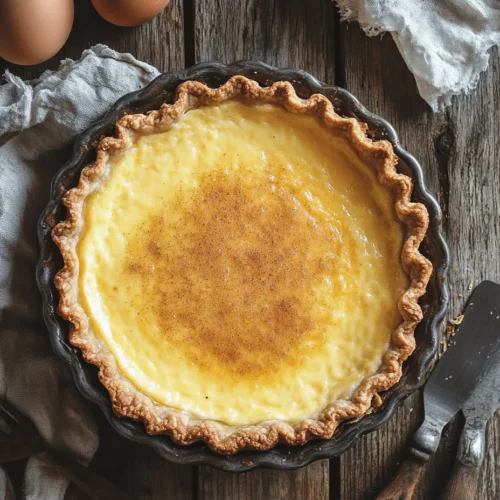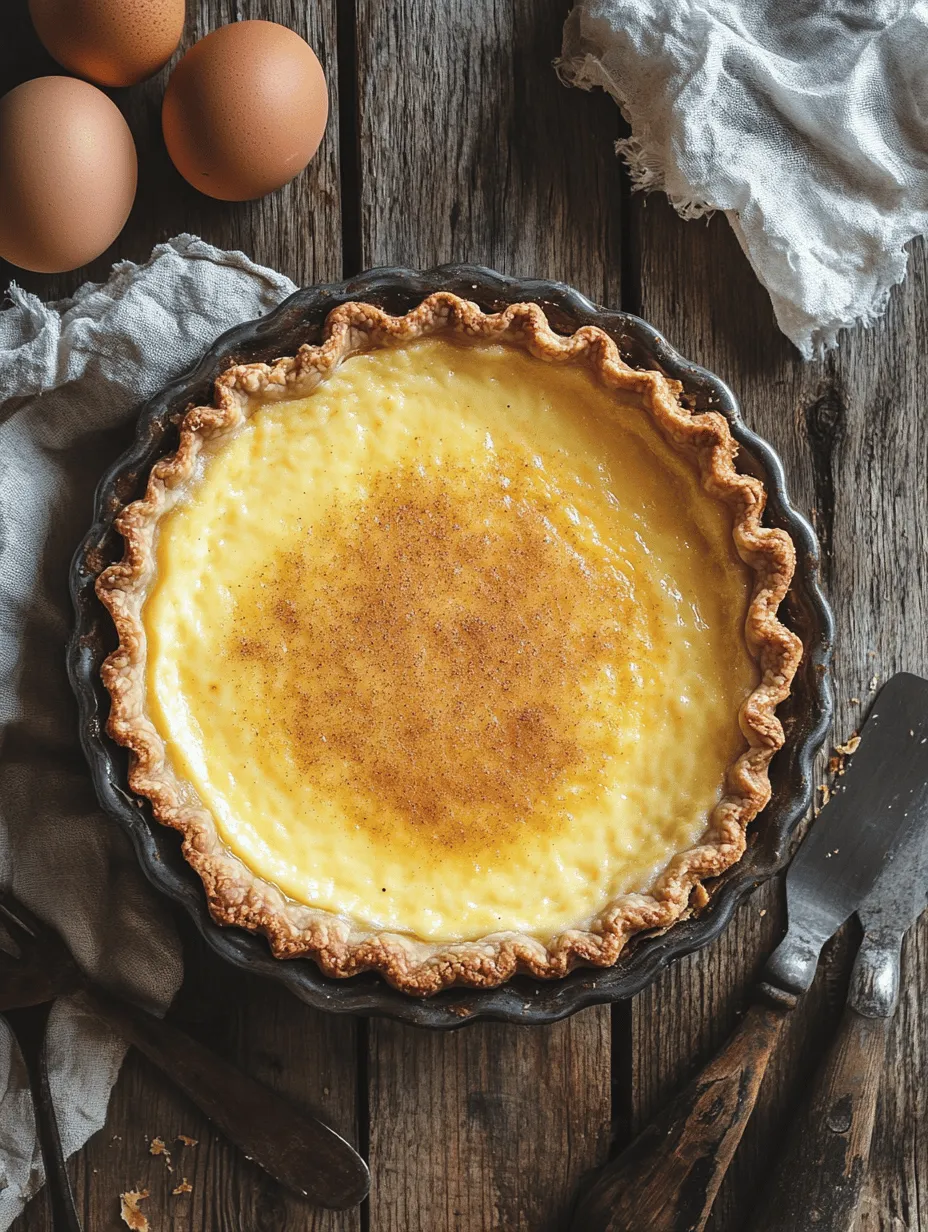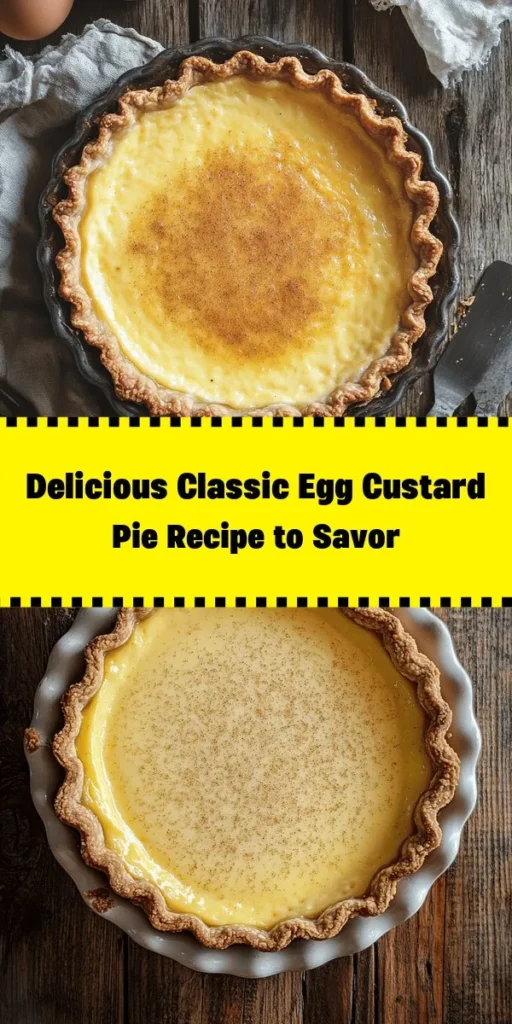Introduction
Egg custard pie is a timeless dessert that has graced the tables of many households for generations. This classic dish, with its velvety texture and subtly sweet flavor, serves as a comforting reminder of simpler times and family traditions. The rich, creamy custard filling is enveloped in a flaky pie crust, making it a delightful treat that appeals to both the young and the old alike. Whether enjoyed after a family dinner or at a festive gathering, egg custard pie brings a sense of nostalgia and warmth that few desserts can replicate.
The history of egg custard pie is as rich as its flavor. It has its roots in medieval Europe, where custards were often used in both savory and sweet dishes. Over the centuries, custard pies evolved, with various cultures adding their own unique twists to the recipe. In America, particularly in the Southern states, egg custard pie became a beloved staple, often associated with home-cooked meals and family gatherings. This beloved dessert’s enduring popularity is a testament to its comforting qualities and the joy it brings to those who indulge in it.
To achieve the perfect egg custard pie, it is essential to use simple yet high-quality ingredients. Each component plays a crucial role in creating the smooth, creamy custard filling that defines this dessert. From the eggs to the milk, the quality of the ingredients can significantly affect the final outcome, ensuring that each slice of pie is as delightful as the last.
The Allure of Classic Egg Custard Pie
Egg custard pies hold a special place in many culinary traditions around the world. In various cuisines, custard-based desserts are celebrated not only for their taste but also for their versatility. In French cuisine, for instance, crème brûlée showcases a similar custard base, topped with a layer of caramelized sugar. In contrast, the British enjoy their own version of custard tart, often featuring a flaky pastry crust filled with a rich custard mixture. This cultural significance highlights the universal love for custard desserts and their ability to bring people together.
For many, egg custard pie is more than just a dessert; it is a vessel for cherished memories. The process of making this pie often involves family, with generations passing down their cherished recipes. Picture a grandmother teaching her grandchildren how to mix the custard, the smell of vanilla wafting through the kitchen, and laughter echoing as they share stories over the mixing bowl. These moments create lasting bonds and traditions that are carried on with each successive generation.
The versatility of egg custard pie also makes it a favorite for various occasions. It can be served warm or chilled, making it suitable for any season. During holiday gatherings, it often finds its place alongside other festive desserts, while in the summer, it can be a refreshing end to a backyard barbecue. Whether celebrating a birthday, holiday, or simply enjoying a quiet evening at home, egg custard pie offers a delightful way to indulge and create memories.
Ingredients Breakdown
To create a delicious classic egg custard pie, it is vital to understand the role of each ingredient in the recipe. Below, we delve into the essential components that contribute to the pie’s delightful flavor and texture:
Pre-Made Pie Crust
While some may choose to make their own pie crust from scratch, using a pre-made pie crust offers convenience without sacrificing quality. Available in both frozen and refrigerated forms, pre-made crusts save time while ensuring a sturdy base for the custard filling. When selecting a pre-made crust, look for options made with simple ingredients and avoid those that contain preservatives. This allows for a crisp, flaky texture that complements the creamy custard perfectly.
Eggs
Eggs are the star ingredient in any custard-based dessert, providing structure and richness. Freshness is key; always opt for high-quality eggs, as they will yield the best flavor and texture. The proteins in eggs coagulate during baking, helping to set the custard and give it that signature smoothness. For the best results, use large eggs, as they are the standard size for most recipes.
Granulated Sugar
Granulated sugar is essential for sweetening the custard. It not only adds sweetness but also contributes to caramelization during baking, resulting in a delightful golden crust on the top of the pie. Adjust the sugar to your taste preference, keeping in mind that the sweetness should complement the other flavors without overpowering them.
Whole Milk
Whole milk forms the foundation of the custard, providing the necessary creaminess that makes this dessert so indulgent. Its higher fat content compared to skim or low-fat milk ensures a richer flavor and texture. For those looking for an even creamier custard, substituting a portion of whole milk with heavy cream can elevate the dish to new heights.
Vanilla Extract
Vanilla extract enhances the overall flavor profile of the custard, adding warmth and depth. Opt for pure vanilla extract rather than imitation vanilla for the best results. A little goes a long way, so use it sparingly to allow the other flavors to shine through.
Ground Nutmeg
Ground nutmeg adds a touch of warmth and spice to the custard, making it a staple in many custard pie recipes. It pairs beautifully with the sweetness of the sugar and the richness of the milk and eggs. Nutmeg’s aromatic qualities contribute to the pie’s comforting essence, evoking memories of cozy gatherings and family meals.
Salt
Though only a small amount is needed, salt plays a critical role in balancing the flavors of the pie. It enhances the sweetness of the sugar and helps to round out the overall taste of the custard. Be sure to use fine sea salt for the best distribution throughout the mixture.
Heavy Cream (Optional)
For those looking to create an ultra-rich custard, adding heavy cream can enhance the creaminess of the filling. While it is not necessary, the optional addition of heavy cream can elevate the indulgence of the pie, resulting in a decadent treat that melts in your mouth.
Tips on Selecting the Best Ingredients
When it comes to making the perfect egg custard pie, selecting the right ingredients is crucial. Here are some tips to ensure you are using the best components for your creation:
1. Choose Fresh Eggs: Always use the freshest eggs available. Consider buying organic or free-range eggs for improved flavor and quality.
2. Opt for Whole Milk: Avoid low-fat or skim milk, as they can lead to a less creamy texture. Whole milk is essential for achieving that velvety custard.
3. Select Pure Vanilla Extract: The quality of vanilla extract can make a significant difference in flavor. Look for pure vanilla extract rather than imitation for an authentic taste.
4. Use Fresh Nutmeg: If possible, purchase whole nutmeg and grate it yourself. Freshly grated nutmeg offers a more potent flavor than pre-ground versions.
5. Inspect the Pie Crust: If using a pre-made pie crust, read the ingredient list carefully. Choose one with minimal additives for the best results.
Preparation Guide
Now that we’ve explored the essential ingredients for your classic egg custard pie, it’s time to dive into the preparation process. Follow these step-by-step instructions to create a delicious custard that’s sure to impress.
Step 1: Preheat the Oven
Before you begin mixing your ingredients, preheat your oven to 350°F (175°C). Preheating is essential, as it ensures that the pie bakes evenly and sets properly. An adequately warmed oven will help create the perfect custard texture while giving the pie a beautiful golden color.
Step 2: Prepare the Pie Crust
If you are using a pre-made pie crust, remove it from the packaging and place it in a 9-inch pie pan. Gently press the crust into the pan to ensure it fits snugly, taking care not to stretch it. Use your fingers to crimp the edges for an attractive finish.
If desired, you can par-bake the crust before adding the custard filling to prevent a soggy bottom. To do this, line the crust with parchment paper and fill it with pie weights or dried beans. Bake for about 10 minutes, then remove the weights and parchment paper and bake for an additional 5 minutes until lightly golden. Allow the crust to cool slightly before adding the custard.
Step 3: Whisk the Ingredients
In a large mixing bowl, combine the eggs and granulated sugar. Whisk them together until the mixture is smooth and well blended. Next, add the whole milk and heavy cream (if using), mixing until fully incorporated. Stir in the vanilla extract, ground nutmeg, and a pinch of salt, ensuring all the ingredients are evenly distributed.
Step 4: Pour the Custard into the Crust
Once your custard mixture is ready, carefully pour it into the prepared pie crust. Take your time to avoid splashing and ensure an even distribution. The custard should fill the crust without overflowing, so if you have leftover custard, you can bake it in a small ramekin as a mini custard treat.
Step 5: Bake the Pie
Place the pie in the preheated oven and bake for approximately 40-45 minutes. The custard should be set around the edges but still slightly jiggly in the center. Be cautious not to overbake, as this can lead to a grainy texture.
Step 6: Cool and Serve
Once baked, remove the pie from the oven and allow it to cool at room temperature for about 15 minutes. Then, transfer it to the refrigerator to chill for at least 2 hours before serving. Chilling the pie allows the flavors to meld and enhances the custard’s texture.
With these detailed steps, you are well on your way to creating a classic egg custard pie that will surely delight your family and friends. Enjoy the process as much as the final product, and relish in the comforting flavors of this beloved dessert.

Mixing the Custard: Achieving a Smooth and Frothy Mixture
To create a classic egg custard pie that boasts a silky texture and rich flavor, the initial mixing of ingredients is crucial. Start by cracking your eggs into a mixing bowl and whisking them until they are fully blended. This is an essential step; ensure that the yolks and whites are combined without any streaks. For a smoother custard, you can use a blender or an electric mixer on low speed for about 30 seconds.
Next, gradually add the sugar to the eggs while continuing to whisk. This helps to dissolve the sugar evenly, preventing any gritty texture in the final custard. Once the sugar is incorporated, slowly pour in the milk and cream mixture. Make sure to use whole milk and heavy cream for the best flavor and texture. Whisk the mixture gently to incorporate air, which will make the custard frothy. Be careful not to over-whisk, as too much air can create bubbles that may cause the custard to puff up during baking.
To enhance the flavor, add a pinch of salt and a teaspoon of vanilla extract. The salt balances the sweetness, while the vanilla adds depth. If you prefer a hint of nutmeg, a pinch can also be added at this stage. Once thoroughly mixed, strain the custard mixture through a fine mesh sieve into another bowl or directly into the pie crust. This step is crucial as it removes any lumps or bits of cooked egg, ensuring a velvety finish.
Pouring the Custard: Best Practices
Pouring the custard mixture into the pie crust requires care to avoid any spills or mishaps. To ensure that the custard fills the crust evenly, place the pie crust on a baking sheet before pouring. This setup will make it easier to transfer the pie to and from the oven without spilling.
Begin by pouring the custard slowly into the crust, starting from the center and allowing it to flow outward. This technique minimizes the chance of splashing. If you notice any bubbles forming on the surface, gently tap the pie dish on the counter to release them before baking. Alternatively, you can run a skewer or a toothpick through the custard to pop any bubbles that may have formed.
Importance of Timing in the Baking Process
Baking a custard pie requires precise timing to achieve the perfect texture. Preheat your oven to 350°F (175°C) before placing your pie inside. The custard should bake for approximately 45 to 50 minutes. However, oven temperatures can vary, so it’s essential to check for doneness at around the 40-minute mark.
To test if the custard is set, gently jiggle the pie dish; the center should have a slight wobble but not be liquid. You can also insert a knife or toothpick into the custard; it should come out clean or with just a few moist crumbs attached. If you find that the custard is still too liquid, return it to the oven and continue baking, checking every 5 minutes until it’s done.
Baking the Perfect Custard
The baking process is an art that involves understanding temperature control and its effects on the custard’s texture. The key is to maintain a steady temperature throughout the baking. If the temperature is too high, the custard can curdle or become rubbery. For the best results, consider using a water bath (bain-marie) during baking. To do this, place the pie dish inside a larger pan filled with hot water, which helps regulate the heat and ensures even cooking of the custard.
Importance of Cooling
Once your custard pie is baked to perfection, it’s essential to let it cool gradually. Removing the pie from the oven, you should let it rest at room temperature for at least 30 minutes before refrigerating. This cooling period allows the custard to set completely, developing a smooth texture. After cooling, cover the pie with plastic wrap and place it in the refrigerator to chill for a minimum of 2 hours. This chilling step not only enhances the flavor but also makes slicing easier.
Signs of a Perfectly Baked Custard Pie
A perfectly baked egg custard pie has several visual and textural indicators. The top should be a beautiful golden brown, and you may notice a slight sheen on the surface. When cut, the custard should be smooth and creamy, holding its shape without being too firm or too runny. A slight jiggle in the center is acceptable, as it will continue to set during the cooling phase.
Chilling and Serving Suggestions
Chilling your egg custard pie before serving is a vital step that enhances its flavors and makes it more refreshing. Once the pie has cooled in the refrigerator, it can be served chilled or at room temperature, depending on your preference.
For an elegant presentation, consider garnishing with a light dusting of freshly grated nutmeg or cinnamon on top of the custard before serving. You can also add a dollop of whipped cream for a luxurious touch. If you want to elevate the dessert further, consider serving it with a side of fresh berries, such as raspberries or strawberries, which add a delightful contrast to the richness of the custard.
Pairing Suggestions
Egg custard pie pairs beautifully with a variety of accompaniments. For beverages, consider serving it with a glass of sweet tea, coffee, or a dessert wine like Moscato. If you want to keep it simple, a scoop of vanilla ice cream or a side of fruit compote complements the custard’s creamy texture perfectly.
Common Mistakes to Avoid
Creating the perfect egg custard pie can be a rewarding experience, but there are common pitfalls to avoid:
– Overbaking: One of the most frequent mistakes is overbaking the custard. If the pie is left in the oven for too long, it can become rubbery and dry. Always start checking for doneness around 40 minutes and rely on the jiggle test to gauge its readiness.
– Underbaking: Conversely, underbaking can lead to a runny custard. Ensure that the center is just set, as it will firm up upon cooling. If in doubt, it’s better to err on the side of slightly underbaking than overbaking.
– Ingredient Substitutions: While experimenting in the kitchen can be fun, certain ingredient substitutions can drastically affect the outcome of your custard. For instance, using low-fat milk instead of whole milk will change the texture and richness of the pie. Stick to the recommended ingredients for the best results.
Nutritional Information
An average slice of homemade egg custard pie contains approximately 250-300 calories. It is essential to be mindful of portion control, especially if you’re watching your sugar intake or calorie consumption. While custard pie is a delightful treat, enjoying it in moderation will ensure you can savor its rich flavors without overindulging.
Conclusion
The charm of a classic egg custard pie lies in its simplicity and comforting flavors. This timeless dessert has been a staple in many households for generations, bringing joy and satisfaction to those who bake and share it. With its creamy custard filling and flaky crust, it offers a delightful experience that is perfect for any occasion.
Encouraging you to try making this classic dessert at home, remember that baking is not just about following a recipe—it’s about creating lasting memories. The joy of sharing a homemade egg custard pie with loved ones is an experience that transcends generations. So gather your ingredients, embrace the process, and enjoy the comfort and satisfaction that comes from baking this beloved pie.



